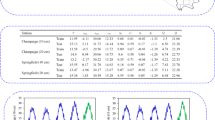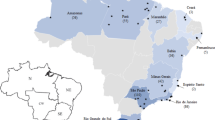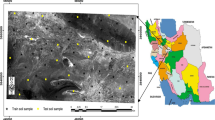Abstract
Soil temperature is one of the most important glacio-meteorological parameters that play a critical role in glacier energy and mass balance dynamics, surface hydrological processes, and glacier-atmosphere interaction. However, the availability of the data is acutely scarce in the Himalayan glaciated region. In this study, we applied artificial neural network (ANN) models for the prediction of soil temperature of glacial forefield region of the Pindari Glacier (Central Himalaya). Three-layer feed-forward ANN models were developed and tested for estimating multi-depth soil temperatures using concurrent and antecedent air-soil temperature data for one complete annual cycle as inputs for the models. Models with different combinations of input variables were tested, and best sets of variables were selected based on the prediction accuracy. Rigorous statistics were further employed to compare the performances of different models. High concurrence was obtained between ANN-estimated and measured soil and air temperatures as evident by various correlation coefficients and error ranges. In a boarder perspective, our results point toward the applicability of developed ANN models to provide robust soil temperature prediction for the glacial forefield regions of the Central Himalaya.




Similar content being viewed by others
Data availability
The data used in this research is included in the manuscript. Any further data requirement from this central Himalayan glacier site will be available upon reasonable request.
References
Abiodun OI, Jantan A, Omolara AE, Dada KV, Mohamed NA, Arshad H (2018) State-of-the-art in artificial neural network applications: a survey. Heliyon 4(11):00938
Abyaneh HZ, Varkeshi MB, Golmohammadi G, Mohammadi K (2016) Soil temperature estimation using an artificial neural network and co-active neuro-fuzzy inference system in two different climates. Arab J Geosci 9(5):377
Al-Salihi AM, AL-Ramahy ZA (2017) A neural network model for estimation soil temperature bases on limited meteorological parameters in selected provinces in Iraq. J Appl Adv Res 2(5):292–300
Anctil F, Lauzon N (2004) Generalisation for neural networks through data sampling and training procedures, with applications to streamflow predictions. Hydrol Earth Syst Sci 8:940–958
Angela K, Taddeo S, James M (2011) Predicting global solar radiation using an artificial neural network single-parameter model. Advances in Artificial Neural Systems 2011:16
Azam MF, Wagnon P, Berthier E, Vincent C, Fujita K, Kargel JS (2018) Review of the status and mass changes of Himalayan-Karakoram glaciers. J Glaciol 64(243):61–74
Bechrakis DA, Sparis PD (2004) Correlation of wind speed between neighboring measuring stations. IEEE Trans Energy Convers 19(2):400–406
Bilgili M (2010) Prediction of soil temperature using regression and artificial neural network models. Meteorog Atmos Phys 110(1-2):59–70
Bilgili M, Sahin B, Sangun L (2013) Estimating soil temperature using neighboring station data via multi-nonlinear regression and artificial neural network models. Environ Monit Assess 185:347–358
Bolch T, Kulkarni A, Kääb A, Huggel C, Paul F, Cogley JG, Frey H, Kargel JS, Fujita K, Scheel M, Bajracharya S (2012) The state and fate of Himalayan glaciers. Science 336(6079):310–314
Braley WA, Zarling JP (1991) MUT1D: user-friendly one-dimensional thermal model. In Cold Regions Engineering ASCE 1-10
Citakoglu H (2017) Comparison of artificial intelligence techniques for prediction of soil temperatures in Turkey. Theor Appl Climatol 130(1-2):545–556
Das DB, Thirakulchaya T, Deka L, Hanspal NS (2015) Artificial neural network to determine dynamic effect in capillary pressure relationship for two-phase flow in porous media with micro-heterogeneities. Environ Process 2(1):1–18
Dawson CW, Wilby RL (2001) Hydrological modelling using artificial neural networks. Prog Phys Geogr 25(1):80–108
Fang X, Luo S, Lyu S (2019) Observed soil temperature trends associated with climate change in the Tibetan Plateau, 1960–2014. Theor Appl Climatol 135(1-2):169–181
Gao Z, Horton R, Wang L, Liu H, Wen J (2008) An improved force-restore method for soil temperature prediction. Eur J Soil Sci 59:972–981
Garg PK, Shukla A, Jasrotia AS (2017) Influence of topography on glacier changes in the central Himalaya, India. Glob Planet Chang 155:196–212
Garg PK, Shukla A, Jasrotia AS (2019) Dynamics of the four major central Himalayan glaciers: spatio-temporal trends, influencing factors and glacier health. Himal Geol 40(2):141–148
Hock R (2005) Glacier melt: a review of processes and their modelling. Prog Phys Geogr 29(3):362–391
Holmes TRH, Jackson TJ, Reichle RH, Basara JB (2012) An assessment of surface soil temperature products from numerical weather prediction models using ground-based measurements. Water Resour Res 48:W02531. https://doi.org/10.1029/2011WR010538
Hu Q, Feng S (2003) A daily soil temperature dataset and soil temperature climatology of the contiguous United States. Jr Appl Meteorol 42(8):1139–1156
Hu G, Zhao L, Wu X, Li R, Wu T, Xie C, Qiao Y, Shi J, Cheng G (2016) An analytical model for estimating soil temperature profiles on the Qinghai-Tibet Plateau of China. Journal of Arid Land 8(2):232–240
Isik S, Kalin L, Schoonover JE, Srivastava P, Lockaby BG (2013) Modeling effects of changing land use/cover on daily streamflow: an artificial neural network and curve number based hybrid approach. Jr Hydrol 485:103–112
Kesarwani K, Pratap B, Bhambri R, Mehta M, Kumar A, Karakoti I, Verma A, Dobhal DP (2012) Meteorological observations at Chorabari and Dokriani glaciers, Garhwal Himalaya. India J Ind Geol Cong 4(1):125–128
Khandelwal DD, Singhal M (2019) Developing a low-cost weather monitoring system for data-sparse regions of the Himalayas. Weather. https://doi.org/10.1002/wea.3647
Kişi Ö (2008) Stream flow forecasting using neuro-wavelet technique. Hydrological Processes: An International Journal 22(20):4142–4152
Kisi O, Tombul M, Mohammad ZK (2015) Modeling soil temperatures at different depths by using three different neural computing techniques. Theor Appl Climatol 121(1-2):377–387
Konate AA, Pan H, Khan N, Yang JH (2015) Generalized regression and feed-forward back propagation neural networks in modelling porosity from geophysical well logs. J Pet Explor Prod Technol 5(2):157–166
Maqsood I, Khan MR, Huang GH, Abdalla R (2005) Application of soft computing models to hourly weather analysis in southern Saskatchewan, Canada. Eng Appl Artif Intell 18(1):115–125
Maurer JM, Schaefer JM, Rupper S, Corley A (2019) Acceleration of ice loss across the Himalayas over the past 40 years. Sci Adv 5(6):eaav7266
Mehdizadeh S, Behmanesh J, Khalili K (2017) Evaluating the performance of artificial intelligence methods for estimation of monthly mean soil temperature without using meteorological data. Environ Earth Sci 76(8):325
Qi J, Li S, Li Q, Xing Z, Bourque CPA, Meng FR (2016) A new soil-temperature module for SWAT application in regions with seasonal snow cover. Jr Hydrol 538:863–877
Schaetzl RJ, Tomczak DM (2001) Wintertime temperatures in the fine-textured soils of the Saginaw Valley, Michigan. The Great Lakes Geographer 8(2):87–99
Shahin MA, Jaksa MB, Maier HR (2008) State of the art of artificial neural networks in geotechnical engineering. Electron J Geotech Eng 8:1–26
Shamseldin AY (1997) Application of a neural network technique to rainfall-runoff modelling. Jr Hydrol 199(3-4):272–294
Singh N, Singhal M, Chhikara S, Karakoti I, Chauhan P, Dobhal DP (2019a) Radiation and energy balance dynamics over a rapidly receding glacier in the central Himalaya. Int J Climatol 40(1):1–21. https://doi.org/10.1002/joc.6218
Singh J, Singh N, Chauhan P, Yadav RR, Bräuning A, Mayr C, Rastogi T (2019b) Tree-ring δ18O records of abating June–July monsoon rainfall over the Himalayan region in the last 273 years. Quat Int 532:48–56
Suni T, Guenther A, Hansson HC, Kulmala M, Andreae MO, Arneth A, Artaxo P, Blyth E, Brus M, Ganzeveld L, Kabat P (2015) The significance of land-atmosphere interactions in the Earth system—iLEAPS achievements and perspectives. Anthropocene 12:69–84
Tabari H, Sabziparvar AA, Ahmadi M (2011) Comparison of artificial neural network and multivariate linear regression methods for estimation of daily soil temperature in an arid region. Meteorog Atmos Phys 110:135–142
Tabari H, Talaee PH, Willems P (2015) Short-term forecasting of soil temperature using artificial neural network. Meteorol Appl 22(3):576–585
Wu W, Tang XP, Guo NJ, Yang C, Liu HB, Shang YF (2013) Spatiotemporal modeling of monthly soil temperature using artificial neural networks. Theor Appl Climatol 113(3-4):481–494
Xu C, Sano M, Dimri AP, Ramesh R, Nakatsuka T, Shi F, Guo Z (2018) Decreasing Indian summer monsoon on the northern Indian sub-continent during the last 180 years: evidence from five tree-ring cellulose oxygen isotope chronologies. Clim Past 14(5):653–664
Yonaba H, Anctil F, Fortin V (2010) Comparing sigmoid transfer functions for neural network multistep ahead streamflow forecasting. J Hydrol Eng 15(4):275–283
Yu H, Wilamowski BM (2011) Levenberg-Marquardt training. Industrial electronics handbook 5(12):1
Acknowledgments
The Department of Science and Technology (DST) is thankfully acknowledged for the Fast-track fellowship to the corresponding author. N.S. sincerely acknowledges DST for the financial support to set up meteorological stations at the Pindari Glacier (File No. SR/FTP/ES-166/2014). Authors are thankful to the Centre for Glaciology (CFG) and Director, Wadia Institute of Himalayan Geology (WIHG) for all logistical support.
Author information
Authors and Affiliations
Contributions
M.S. and N.S. conceived, designed, and performed this study. Authors contributed equally to analyses and interpretation of results and drafting of the manuscript.
Corresponding author
Ethics declarations
Conflict of interest
The authors declare that they have no conflict of interest.
Code availability
Codes utilized in this study may be requested from the authors.
Additional information
Publisher’s note
Springer Nature remains neutral with regard to jurisdictional claims in published maps and institutional affiliations.
Rights and permissions
About this article
Cite this article
Singhal, M., Gairola, A.C. & Singh, N. Artificial neural network-assisted glacier forefield soil temperature retrieval from temperature measurements. Theor Appl Climatol 143, 1157–1166 (2021). https://doi.org/10.1007/s00704-020-03498-5
Received:
Accepted:
Published:
Issue Date:
DOI: https://doi.org/10.1007/s00704-020-03498-5




